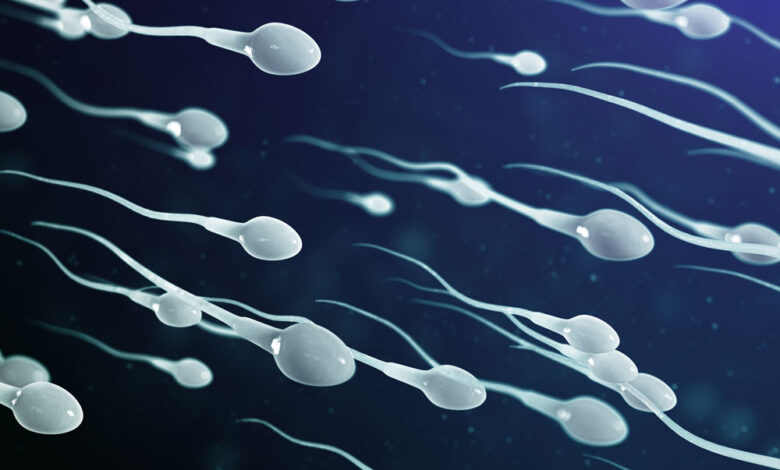How long does sperm live in a woman’s body?

Sperm Cells Can Live for a Couple of Days inside a Woman’s Body
The majority of couples who are trying to conceive, are asking this question: How long does sperm live in a woman’s body? To answer this question and understand how fertilization happens you need to continue reading this informative article.
Even if the sperm sneaks into a woman’s body to make this long and difficult journey, he still has only one chance in 200 million to fertilize an egg (provided that any of the sperm from this loop reaches this place). Since sperm can only live in the female reproductive tract for up to 5 days, only a small amount of sperm can survive even a long journey through the female reproductive tract.
Tips to Conceive Fast
Therefore, couples trying to conceive should schedule multiple sex sessions on the days just before ovulation. When trying to conceive, many couples plan to have intercourse between days 11 and 14 of a woman’s 28-day cycle. Biologically speaking, ovulation day is the only day you can get pregnant, as this is the time when sperm and egg actually meet.
Studies have shown that the maximum period your sperm can survive in your partner’s body is 5 days. Research shows that the average lifespan of sperm after ejaculation or insertion into the female reproductive system is about three days. However, it depends on where he is in his menstrual cycle – with the right timing, the strongest sperm can last up to five days.
In short, how long sperm can live in the vagina depends on the conditions it is exposed to and the type of cervical mucus (if any). Research shows that if semen gets into the vagina when cervical mucus is most fertile in the days before ovulation, pregnancy is not only possible but also more likely. Sperm in the vagina can live in the mucus of the cervix or upper genital tract for three to five days, allowing fertilization while the sperm is alive. However, in fact, sperm can live for up to 5 days in a woman’s body after ejaculation.
Sperm Cells Can Not Live Outside a Woman’s Body
This does not mean that sperm cells can be stored outside a woman’s body for a long time; as soon as they dry out, they die. Most of the sperm die in the uterus within 24-48 hours after ejaculation, and the longer it has been since ejaculation, the less likely the egg is fertilized. The exact length of survival depends on the environment in which they are released and how quickly the fluid surrounding the semen dries up. The lifespan of semen after ejaculation depends on the circumstances.
How long does frozen sperm survive?
Ejaculated sperm can survive for several days in the female reproductive tract. As long as the sperm is alive-up to five days, they can still fertilize the egg. Sperm collected and frozen by a doctor can survive indefinitely under the right conditions.
Sperm can be stored for up to 55 years and can still fertilize an egg. But the normal storage period is 10 years. It is unlikely that sperm will last longer than an hour outside the body. Even in high body temperatures. Even at room or body temperature, sperm are unlikely to survive for more than an hour outside the body.
According to the American Pregnant Association, during ovulation – when the vaginal climate is particularly humid and hot – sperm can last for up to five days. Healthy sperm can live from a couple of hours to five days after intercourse. The average lifespan of sperm entering the fallopian tube is three to four days. Although some may survive up to a week. In order for conception to occur, at least one healthy sperm must wait in the fallopian tube during ovulation. And must be able to fertilize an egg within 12-24 hours after the birth of the egg.
When Pregnancy is Likely to Occur?
The highest rates of pregnancy are recorded when the egg and sperm combine within 4-6 hours after ovulation. By paying close attention to how your body responds to increased estrogen levels in the first two weeks of your menstrual cycle, you can start predicting ovulation. For example, knowing that sperm lives in the female reproductive system for 3-5 days means that you can have intercourse a few days before your partner ovulates and still lead to pregnancy. Understanding how long sperm live in and out of your body can help if you’re trying to get pregnant or trying to avoid getting pregnant.
In vitro fertilization, sperm is injected into an egg for fertilization in a laboratory. And then placed back into the woman’s uterus. The IUI places sperm directly into the woman’s uterus, so she does not need to float out of the vagina through the cervix. Once inside the female genital tract, the sperm must travel through the cervix into the uterus. To reach the fallopian tubes and the female ovum.
The lifespan of sperm in a woman’s body
Most sperm die in the female genital tract within 1-2 days after ejaculation. The lifespan of sperm in a woman’s body. After ejaculation, semen can live in a woman’s body for about 5 days. The fluid in the female genital tract contains all the nutrients that sperm needs to survive during this time.
Especially in a woman’s womb, on average, sperm can be stored for up to two days. Without fertile cervical fluid, sperm can survive in the vagina or uterus for no more than a few hours. If they can survive that far. Many sperm cells die in the highly acidic vagina within the first 12 hours. However, on a hot, humid surface like a hot tub, sperm will thrive, so they will live longer.
The pH of The Reproductive Tract
During ovulation, the pH of the reproductive tract becomes less acidic and sperm can live a little longer. Which gives them more time to swim up to the cervix. Thanks to the fertile, nutrient-rich cervical mucus, sperm can live longer in a woman’s body. And have more time to reach the egg or simply stay until the egg is released. It is possible that if sperm ejaculates near the vulva, it can reach the vagina and lead to pregnancy. But once the sperm dries on the skin, it cannot fertilize the egg. Even if it gets wet again in the shower.
How Quickly Does Semen Dry
This will depend on your health and age, but most sperm will dry and die within 15-30 minutes of contact with skin or surfaces. Says Kimberly Langdon MD.
No matter what surface it may be on, sperm can no longer lead to pregnancy. Once semen, the liquid that holds the sperm, has dried, it is considered dead.
Michael A. Witt MD is a male fertility specialist and urologist at Reproductive Biology Associates. A dry, cold surface such as a bed sheet can cause sperm to dry quicker than one on a warmer surface, like human skin.
Langdon says that although sperm can survive for a short time on the skin and outside of the body, there is very little chance it will fertilize an egg or cause pregnancy. To have any chance of getting pregnant, a person would need to touch the sperm first and then touch their vagina.
Can Sperm Live for Up to 7 Days?
Yes, sperm can live inside the female reproductive tract for up to 5 to 7 days under ideal conditions. After ejaculation, sperm travel through the cervix and into the uterus, where they can survive in the cervical mucus. The cervical mucus becomes more hospitable around the time of ovulation, providing the nourishment and environment sperm need to survive for a longer period.
Most sperm die within the first 24 to 48 hours after intercourse. However, in the days leading up to ovulation, when cervical mucus is most favorable, some sperm may remain viable for up to a full week. This is why pregnancy can occur even if intercourse happens several days before ovulation—because sperm are still alive when the egg is released.
Outside of the female body, sperm generally do not last long. When exposed to air, sperm quickly die, often within minutes, especially in dry environments.
Sources:
- American Pregnancy Association: “Sperm can live inside the female body for up to 5 days, and under the best circumstances, up to 7 days” .
- Mayo Clinic: “Sperm that enters the female reproductive tract may live for up to five days, depending on conditions” .
This understanding helps explain how pregnancy can occur even if intercourse happens well before ovulation, as sperm can still be present when the egg is released.




